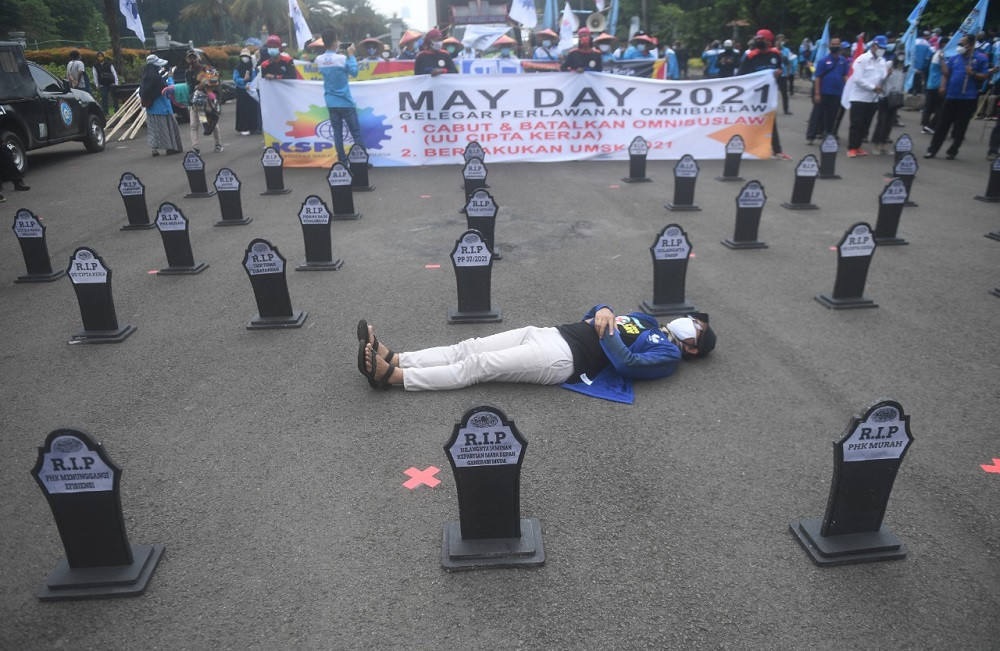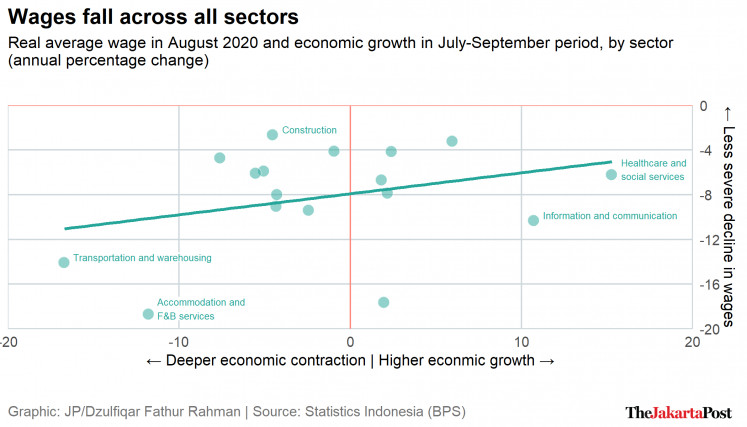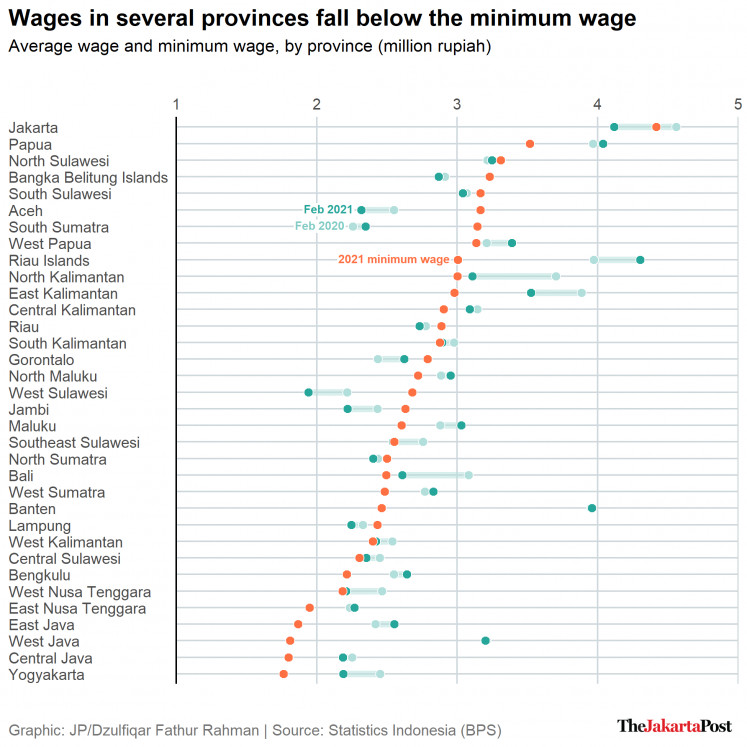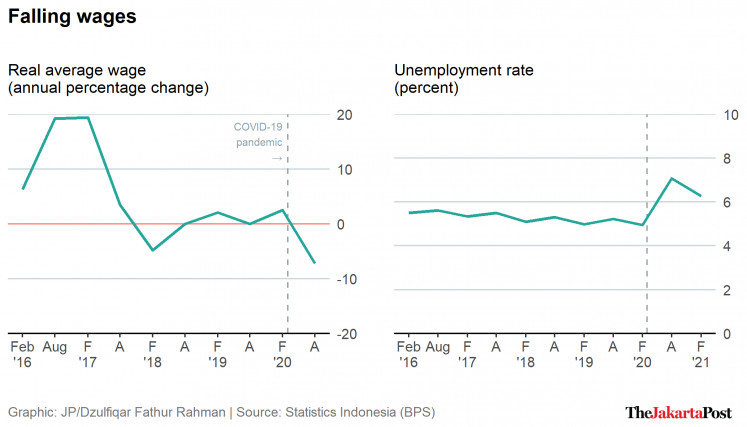COVID-19 takes severe toll on wages
Average wage in Indonesia dropped 1.75 percent yoy to Rp 2.86 million (US$201) in May, but personal incomes have begun to recover in recent months, in line with overall economic improvements.
Change Size

T
he COVID-19 pandemic has led to a general decline in wages as businesses tightened their belts to survive the economic downturn caused by mobility restrictions.
Statistics Indonesia (BPS) reported in early May that average wage had dropped 1.75 percent year-on-year (yoy) to Rp 2.86 million (US$201), but it was up 3.78 percent compared to August 2020, which suggested rapid improvement as the economy begins to recover.
The average real wage recorded its steepest decline since at least 2016 last August, when it was down 7.18 yoy as the economy fell into its first recession in over two decades.
The unemployment rate increased to 6.26 percent this February from 4.94 percent a year earlier, underscoring the pandemic’s impact on the labor market.
Wages fall across all sectors
While average wages contracted across all sectors, the contraction was narrower in sectors that fared better in terms of growth.
The accommodation, food and beverage sector saw the sharpest decline, with real wages declining 18.7 percent yoy last August. This was in line with the sector contracting 11.81 percent in the third quarter of 2020, second only to the transportation and warehousing sector.
More than a year into the pandemic, businesses in some industries were still having to slash wages, said Adi Mahfudz, vice chairman of the National Wage Council (Dapenas), a tripartite body that advises the government on minimum wages.
“Of course, the wage reductions are related to working conditions,” Adi told The Jakarta Post by phone on Friday. “For example, there have been changes in working hours and shifts.”
The situation was particularly difficult in the restaurant and hotel industries, he added, where businesses were operating at between 70 and 80 percent of their normal capacity.
Around 9.3 percent of the total labor force were directly affected by the COVID-19 pandemic. The vast majority have had working hours reduced, while relatively few lost their jobs or were furloughed. Some 15.72 million people were still working reduced hours in February, which marks an improvement from 24.03 million in August.
Wages fall below legal minimum in some provinces
The government decided last year to leave the regional minimum wage unchanged for 2021. The wage floor is usually increased in line with economic growth and inflation.
Read also: Apindo defends stagnating minimum wage, citing pandemic
In Jakarta, the nation’s COVID-19 epicenter, the average wage dropped 9.74 percent yoy to Rp 4.11 million in February, below the city’s minimum wage of Rp 4.41 million.
Aceh saw wages average Rp 2.54 million to dip below the minimum of Rp 3.16 million even before the pandemic, which then led wages to drop 9.10 percent and further below the region’s minimum.
Nining Elitos, who chairs the Congress of Indonesia Unions Alliance (KASBI), said minimum wages across the country did not adequately cover expenses for food, housing, healthcare and education, and thus did not afford workers a decent standard of living.

Many workers had to borrow money around the 5th of every month, shortly after their last payday, to pay for mortgages, vehicles and other installments, she said.
“There are no decent labor wage standards yet,” Nining told the Post by phone. “So far, wages are just enough to [cover] food to survive. In regions such as Sumatra and Sulawesi, the cost of food is extraordinary, but wages remain low.”
Shinta Kamdani, deputy chairwoman of the Indonesian Employers Association (Apindo), defended the decision to retain the 2020 minimum wage for this year, given that the pandemic had battered cash flow for many businesses.
“Not raising the minimum wage was an important and strategic decision to help companies maintain business continuity,” Shinta told the Post by text message.

Gender wage gap likely to persist
In February, the average wage of male workers was down 2.6 percent yoy to Rp 3.1 million, while it was down 0.66 percent yoy to Rp 2.43 million for female workers. Although the wage contraction was smaller among female workers, their average pay remained lower than their male counterparts.
When male workers in hard-hit sectors faced pay cuts, such as during the pandemic, their wives usually worked or started small businesses to cushion the impact on household finances, said Diahhadi Setyonaluri, an economist at the University of Indonesia’s Demographic Institute. Moreover, low-paying jobs had a higher share of female workers.
Read also: Female workers in Indonesia earn 23% less than their male peers
While a majority of both men and women earn more than Rp 2 million, the proportion of female workers, including casual workers, with a net wage or income between Rp 600,000 and Rp 800,000 was 7.87 percent in February, twice as high as that of men.

“If the [government] assistance for small businesses reaches women currently running small businesses, it is likely they can sustain their participation in the labor market and the gender wage gap will probably change a little,” Diahhadi told the Post in a phone interview.
Household spending
Meanwhile, Bank Mandiri economist Faisal Rachman said the wage decline in February reflected the first quarter’s 2.23 percent yoy contraction in household spending. However, with the recent improvements in wages and the economy, household spending was projected to grow in the second quarter.
“So, for the full year of 2021, I expect household spending to book positive growth, bouncing back from the contraction in 2020,” Faisal told the Post by text message.









